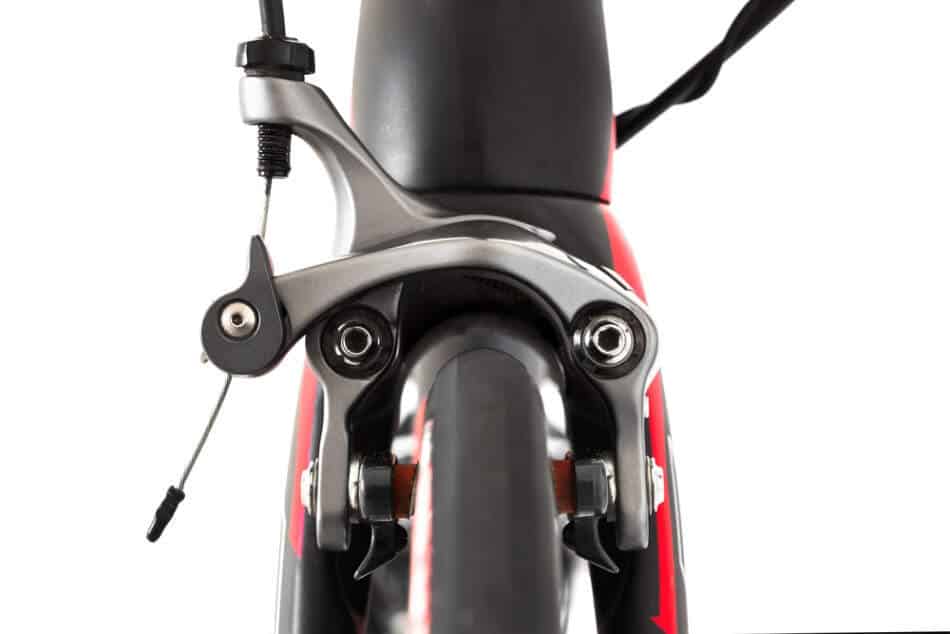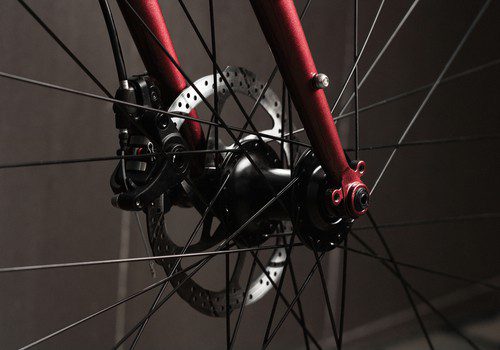Avid bicycle lovers get a lot of use out of their equipment. Bicycles, like any mode of transportation, require regular maintenance. This includes the replacement of brake pads.
Bicycle brake pads do get old and worn down. They should be replaced when they get down to 1 mm of brake compound.
In this article, we will explain brake compound and the durability of bicycle brake pads. We will also explore and compare different types of brake pads available.
How Long Do Bicycle Brake Pads Last?
The longevity of your bike’s brake pads is dependent on the frequency of use, environmental conditions, and maintenance.
The general rule of thumb is that brake pads can last between 500 – 1000 miles. However, it is important to check the condition of your brake pads regularly. For best estimates of how long your brake pads will last, consult with other cyclists on forums such as the one on Roadbike Review’s website.
According to David Arthur at Road.cc, there are many factors besides mileage that impact your brake pads. These include:
- Winter – snow, road salt, and harsh temperatures can impact brake pad durability.
- Excessive braking – braking often due to traffic or terrain causes brake pads to wear down faster.
- Moisture – rain and wet roads or paths can deteriorate brake pads.
- Lack of cleaning – gravel and other debris can get stuck on brake pads and should be cleaned off.
- Low-quality pads – some brake pads are not made of quality material and thus have less durability.
- Terrain – cycling on flat roads or trails will impact the brake pads less than bumpy or hilly terrain. Mountain biking terrain often has the highest impact.
- Rider weight – The brake pads will be affected by rider weight, as heavier riders will take more effort from the brakes to slow the bike.
Of course, riding every day will pose the most significant impact on your brake pads. Bicycling to work or to run errands is a great way to cut down on transportation costs. For those who ride as a means of transportation, it is critical to check on your brake pads at least once a week.
Ideally, you should give them a visual check up every day. This especially is true once you have used them for over a month. There is no realistic or definitive measurement of time for how long brake pads will last. It truly does depend on how often the bike is used and the frequency of brake usage.
Ideally, you should give them a visual check up every day. This especially is true once you have used them for over a month. There is no realistic or definitive measurement of time for how long brake pads will last. It truly does depend on how often the bike is used and the frequency of brake usage.
If you own a bicycle, it is crucial to keep your equipment well maintained. This is both for efficiency and safety. Here are some signs that your brake pads need replacing:
- Squealing sound when braking
- Unresponsive brakes
- The pad will look thinner and worn
When your brake pads have been worn too far down, your bicycle can become unsafe. Once the pads have worn down completely, your brakes are likely to stop working. This is especially dangerous if you are in a situation where you need to brake suddenly, or if you are far from home.
Squealing or other noises coming from the brakes likely mean the brake pads need immediate replacement. Therefore, it is key to not rely on sound to inform you when to replace your brake pads. Instead, you should visually check your pads’ brake compound regularly.
Brake Compound
According to Galfer USA, brake compound is the material on brake pads that faces inward and touches the tire. It can be made up of many different types of materials.
Typically, new brake pads will have around 3-5mm of brake compound on the pad. According to Total Women’s Cycling, once this is worn down to 1 mm, it is time to replace the pads. If you are new to bicycle maintenance, this may be difficult to notice at first. Your first step will need to be determining which type of brake pad you have.
There are two main types of brake pads: rim pads and disc pads. Which kind of pad you need is dependent on what type of brakes your bike has. We will now cover each type in more detail.
Rim vs Disc Brakes
Rim and disc are used to describe both the brake pads and the type of brakes your bicycle uses. While both types have their advantages, there are some important distinctions between the two.
Rim Brakes
Rim brakes apply the pressure used to stop the bicycle to the outside of the rim of the wheel. These types of brakes use calipers and cables. They are also the more traditional of the two.

Below we will cover some pros and cons of rim brakes.
Pros
- They are typically cheaper
- They are lighter and more aerodynamic
- They are easier to repair
Cons
- Decreased performance in rain or wet conditions
- Can damage the tire rim
- More easily damaged from weather and debris
Disc Brakes
Disc brake systems are the newer type. They have become widely popularized for many cyclists. These types of brakes apply pressure to a rotor that is mounted to the hub of the tire.
Disc brakes can be either mechanical or hydraulic. Mechanical will be operated by cables, similar to rim brakes. Hydraulic, comparatively, is operated by fluid.
Here are the pros and cons of disc brakes:

Pros
- They won’t heat or damage the rim
- They work much better in wet weather
- Their power is more easily adjusted
Cons
- They are typically much more expensive
- They are more complicated systems, making them harder to maintain and fix
- They are heavier and have a bulkier aesthetic
Pricing
As we have covered, rim brake systems and pads will typically be less expensive.
On average, rim brake pads range between $10 – $30 per set.
Comparatively, disc brake pads range between $20 – $40 per set.
Which is More Durable
Disc brakes are regarded as more durable overall. They also rely less on friction than rim brakes, meaning the brake pads deteriorate less quickly.
However, rim brakes are still widely used. The durability discrepancy between the two is not so large as to render rim brakes inefficient.
Ultimately, it comes down to personal preferences. Rim brakes are more aesthetically pleasing and easy to maintain, whereas disc brakes are more technologically advanced.
Both types have a few subtypes as well, meaning you can choose what best fits your needs.
Types of Rim Brake Pads
As covered, rim brake pads work with a system of cables that apply pressure to the rim of the bicycle tire.
These systems can be broken down into two main categories: caliper brakes or cantilever brakes.
The biggest difference between these two is the tire size they can fit. Caliper brakes do not open very wide compared to cantilever brakes.
Therefore, cantilever brakes are better is you require a wider tire.
As far as brake pads, there are three common styles to rim brake pads:
- Road
- Threaded Stud
- Smooth Stud
Rim brake pads can also be customized according to what compound material you need. These include:
- Pads made for dry conditions
- Wet weather pads
- Carbon pads, best used if the rims are made of carbon
- Mixed compound for better year-round use
Types of Disc Brake Pads
Choosing a disc brake pad depends on the brake model. The disc must be designed in a specific way to fit specific models.
Therefore, shape and size are typically limited depending on the brake model.
However, you do have a choice of compound material, just like with rim brakes. Below are the primary compounds for disc brake pads.
- Sintered – these are metallic-based pads that are more weather resistant. They tend to be rather noisy but highly durable for changing weather conditions.
- Organic – these are resin-based pads. They are best used in warm, dry conditions. Their durability and efficiency decrease in wet weather or on steep declines..
- Ceramic – ceramic-based pads are currently the most expensive on the market. They are very quiet and weather-resistant but are not recommended for racing.
- Semi-metallic – these pads combine sintered and organic compounds to create a weather-resistant pad that is less noisy than a sintered pad.
Changing Your Brake Pads
As mentioned, changing your brake pads is an essential part of bicycle maintenance.
This can be done either taking your bike to a professional bike shops or by changing them yourself. Replacing brake pads will require you to have specific tools.
For rim brake pads, it will depend on if your pads are road, threaded stud, or smooth stud.
Here are two videos on how to identify your pad type and change rim brake pads:
- How to Replace Brake Pads on a Bike – Rim Brakes by Park Tool
- How To Replace Rim Brake Pads | GCN Tech Basic Road Bike Maintenance by GCN Tech
For disc brake pads, you will most likely need to remove the wheels as well.
Here are two videos on how to change your disc brake pads:
- How To Replace Your Disc Brake Pads by Global Cycling Network
- How to Replace Bicycle Disc Brake Pads by Park Tool
Final Thoughts
Regularly observing your brake pads is essential to keeping your bicycle running smoothly. Be sure to watch for when they become worn down and replace them promptly!
Related articles:
The Pros and Cons of Disc Brakes on A Road Bike
How Often Should Bike Cables Be Replaced?
Four Clear Signs Your Bike Wheels Need Truing
Do Bike Hubs Make A Difference? Here’s the Truth


